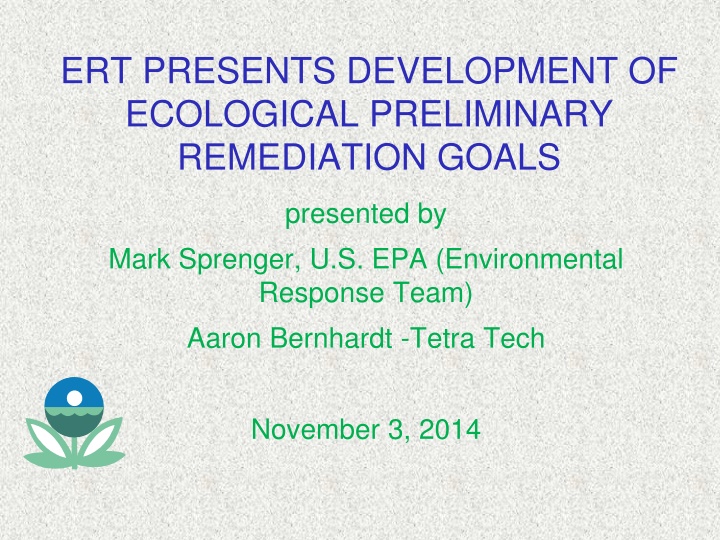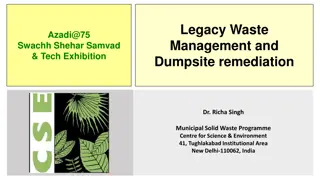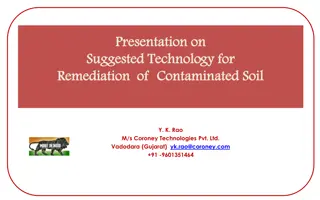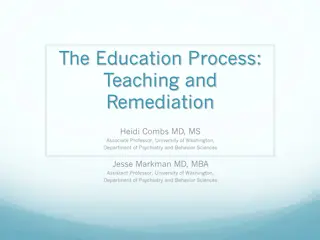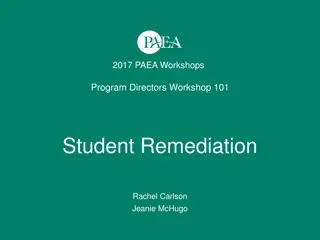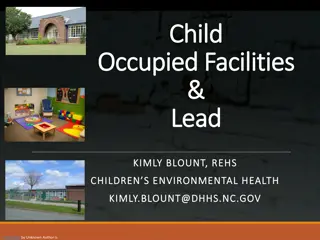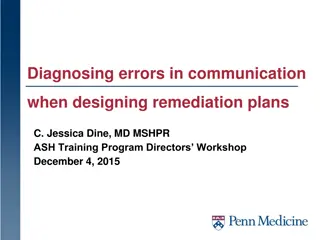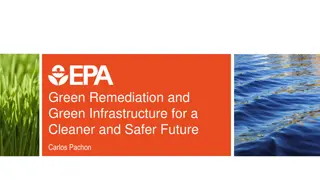Eco-Remediation Goals Development Training Overview
This presentation by Mark Sprenger from the U.S. EPA discusses the development of Ecological Preliminary Remediation Goals (PRGs). It covers the process steps, assumptions, risk information activities, and resources related to ecological risk assessment within the EPA's programs. The training module is part of an ecological risk assessment course offered through the EPA training system. Various guidelines and procedures are outlined for designing, conducting, and managing ecological risk assessments in different environmental remediation scenarios.
Download Presentation

Please find below an Image/Link to download the presentation.
The content on the website is provided AS IS for your information and personal use only. It may not be sold, licensed, or shared on other websites without obtaining consent from the author.If you encounter any issues during the download, it is possible that the publisher has removed the file from their server.
You are allowed to download the files provided on this website for personal or commercial use, subject to the condition that they are used lawfully. All files are the property of their respective owners.
The content on the website is provided AS IS for your information and personal use only. It may not be sold, licensed, or shared on other websites without obtaining consent from the author.
E N D
Presentation Transcript
ERT PRESENTS DEVELOPMENT OF ECOLOGICAL PRELIMINARY REMEDIATION GOALS presented by Mark Sprenger, U.S. EPA (Environmental Response Team) Aaron Bernhardt -Tetra Tech November 3, 2014
ERT PROGRAM TRAINING COURSES This training is one module of an ecological risk assessment course which is offered through the EPA training system Course Descriptions, Class Schedules, and Registration Information are available at: www.trainex.org www.ertpvu.org
ASSUMPTIONS FOR THIS TRAINING First Assumption: Although we are working within the CERCLA or Superfund Program, most concepts and approaches should be applicable or adaptable to other Programmatic or legal situations such as RCRA Primary guidances are from Superfund Program: Ecological Risk assessment Guidance for Superfund (ERAGS): Process for Designing and Conducting Ecological Risk Assessments Interim Final. EPA 540-R-97- 006. OSWER 9285.7-25. June 1997 Guidelines for Ecological Risk Assessment. EPA/630/R- 95/002F. April 1998
ERAGS PROCESS STEP 1: SCREENING-LEVEL (Problem Formulation & Ecological Effects Evaluation) STEP 2: SCREENING-LEVEL (Exposure Assessment & Risk Characterization) SMDP STEP 3: PROBLEM FORMULATION SMDP STEP 4: STUDY DESIGN AND DQO PROCESS SMDP STEP 5: VERIFICATION OF FIELD SAMPLING DESIGN SMDP STEP 6: SITE INVESTIGATION AND DATA ANALYSIS SMDP STEP 7: RISK CHARACTERIZATION STEP 8: RISK MANAGEMENT SMDP
ASSUMPTIONS FOR THIS TRAINING Second Assumption: An ecological risk assessment has been conducted (according to EPA Guidance) with a conclusion that ecological risks do exist Would not calculate PRGs unless there is a risk and that a remediation is being developed
RISK INFORMATION ACTIVITIES IN THE RI/FS PROCESS Site Establishment of remedial action objectives (FS) Development and screening of alternatives (FS) Detailed analysis of alternatives (FS) Project scoping characterization (RI) Review data collected in site inspection Review sampling/data collection plans Refine PRGs based on risk assessment and ARARs Conduct risk evaluation of remedial alternatives Conduct baseline risk assessment Formulate PRGs Determine level of effort for baseline risk assessment HHRA HHRA ERA ERA HHRA ERA
WHY IS IT IMPORTANT THAT THE BASELINE ERA IS COMPLETED? Although PRG development is a Feasibility Study (FS) function, PRGs are often developed and documented while the baseline ERA is being completed Also, although PRG development is typically an extension of Step 7 risk characterization, it is still a FS function
PRGS AND RISK ASSESSMENT Under CERCLA (and following ERAGs) the baseline ERA is done to assess current risk should no action be taken Once there has been the determination (with documentation) that there is substantive ecological risk, under CERCLA, EPA has authority to evaluate remediation alternatives (conduct the FS) This means that within PRG development, the ecological risk evaluations can incorporate risk management options (follow the ERA guidelines 1998). However, the baseline ERA is completed and should not change based upon the PRG assessments
PRGS AND RISK ASSESSMENT The site manager is now at Step 8 of ERAGs and must now select a protective remedy for the site (final site action) PRG development uses the site conceptual model from the baseline ERA and may utilize the same or similar techniques but the questions or goals are different What you can not do is move into the FS, evaluate PRGs and then say, no risk no remediation.
OBJECTIVES OF PRESENTATION Define preliminary remedial goals or PRGs Discuss performance measures List the two criteria with which PRGs must comply Describe how PRGs are derived and used Describe how background is incorporated into the PRG process Discuss risk management
DEFINITION OF PRGS Concentration or exposure goals for individual chemicals for a specific medium and assessment endpoint combination Types ARAR-based (note: many numerical criteria have an option to use alternate/risk-based goals or use-based goals) Risk-based
PRGS Provides remedial design staff with long-term targets to use during analysis and evaluation of remedial alternatives Begin as media-specific screening values that evolve to become site-specific May be identified during the RI scoping step
RELATIONSHIP OF PRGS TO THE CERCLA PROCESS CERCLA REMEDIAL PROCESS Construction Complete/ Deletion 5-year Review Remedial Investigation Remedy Selection and Record of Decision Remedial Design/ Remedial Action Scoping Feasibility Study PRG Development Can be done as part of the Remedial Investigation or Feasibility Study Developed to protect receptors at risk and for chemicals of concern (COCs)
PERFORMANCE MEASURES Performance measures are the criteria by which a remediation is evaluated (i.e., how well it performed.) They can be: Engineering-based (e.g. volume of material to be dredged or an excavation depth) Functionally/structurally-based (e.g. percent plant cover or stream community diversity) Concentration-based (e.g. a chemical-specific clean up goal)
PERFORMANCE MEASURES Site remediation typically is either engineering-based or chemical concentration- based Risk assessment generates the information needed to develop a concentration-based performance measure Risk assessment can also be conducted such that ecological function or structure may be used as the performance measure
PERFORMANCE MEASURES Site manager makes remedial decisions based on the risk assessment/nature and extent of contamination Different remediation options require different risk management decisions, different levels of certainty, and therefore different levels of risk-based information Throughout the site investigation/risk assessment planning step, the site manager needs consider the possible remediation options (including site/land use) Will the site be developed for industrial or residential property? Or will it be open space wildlife habitat?
PERFORMANCE MEASURES PRGs are typical chemical/media specific performance measures which are used to ensure that ecological receptors are protected.
CONCEPTUAL RISK MANAGEMENT SPECTRUM FOR CONTAMINATED SOIL No further study Warranted under CERCLA Site-specific Cleanup Goal/level Response Action clearly warranted PRG PRG PRG "Zero" Screening Level Response Level Very High Concentration Concentration
ECOLOGICAL SOIL SCREENING LEVELS (ECO-SSLS) Chemical concentrations in soil that are protective of ecological receptors that live in the soil or ingest biota that live in/on soil Can be used to identify those chemicals of potential ecological concern (COPECs) in soils requiring further evaluation in a baseline ERA Are not to be used as cleanup levels EPA emphasizes that it is inappropriate to adopt or modify these Eco-SSLs as cleanup standards May be exceptions where all parties agree U.S. EPA 2005
INTENDED USE OF SCREENING LEVELS Screening benchmarks Tools to facilitate prompt identification of areas of concern Not intended to be used as cleanup levels except in rare instances (and agreed by all parties) Site-specific Clean up Levels Response Action NFA "Zero" Response Level Very High Concentration Screening Level Concentration
PRGs - INITIAL DEVELOPMENT What you need Media impacted Chemicals of concern (COCs) Current habitat Potential ARARs Fate and transport properties
PRGs REQUIREMENTS Meet the two threshold criteria Result in residual risks that fully satisfy the National Contingency Plan (NCP) and appropriate regulatory requirements for the protection of human health and the environment Comply with ARARs
ECOLOGICAL PRGS Site-specific or literature-based Variety of methods based on: Chemicals Receptors Available data Remember: Screening levels are not PRGs
ECOLOGICAL PRGS Two primary chemical types Bioaccumulative Protective of upper trophic level receptors from impacts though the food chain Direct Toxicants Protective of lower trophic level receptors from impacts though direct exposure
ECOLOGICAL PRGS Bioaccumulative chemicals Back-calculation of acceptable levels using food chain exposure models: Exposure parameters (i.e., ingestion rate, body weight) Diet composition Toxicity Reference Value (TRV) Bioaccumulation Factors (BAFs) (site-specific) Area Use factor (AUF)
BIOACCUMULATION FACTOR (ESTIMATE TISSUE CONCENTRATIONS) Ct Cs BAF = Rearrange Equation Cs * BAF Ct = BAF = Bioaccumulation Factor (unitless) Ct = Chemical concentration in tissue (mg/kg) Cs = Chemical concentration in soil (mg/kg)
EXAMPLE OF SITE-SPECIFIC BAF Concentrations of DDT in Earthworms Versus Concentration in Soil 60000 y = 7.9765x R = 0.8917 50000 Earthworm Concentration (ug/kg) 40000 30000 20000 10000 0 0 1000 2000 3000 4000 5000 6000 7000 8000 Soil Concentration (ug/kg)
EXAMPLE OF SITE-SPECIFIC BAF Concentration of Lead in Earthworms Versus Concentration in Soil 45 40 Earthworm Lead Concentration (mg/kg) 35 y = 6.5835Ln(x) - 26.382 R2 = 0.8043 30 25 20 15 10 5 0 0 2000 4000 6000 8000 10000 12000 14000 Soil Average Lead Concentration (mg/kg) Wet Weight Log. (Wet Weight)
EXPOSURE ESTIMATE (WILDLIFE) (Conc. in Plants) (Conc. in Invert.) EDsoil =[(Cs * BAFplant * Ip) + (Cs * BAFinv * Ia) + (Cs * Is)] * UF BW EDsoil Cs BAFplant = Plant bioaccumulation factor (kg plant/kg soil) Ip = Ingestion rate of plant material(kg/day) BAFinv = Invertebrate bioaccumulation factor (kg invert./kg soil) Ia = Ingestion rate of animal material (kg/day) Is = Incidental ingestion rate of soil (kg/day) UF = Unit foraging factor (unitless) (assume 1 for screening) BW = Body weight (kg) = Soil exposure dose (mg/kg BW-day) = Concentration in soil (mg/kg)
RISK CALCULATION Exposure Dose (mg/kg BW-day) Toxicity Reference value (mg/kg BW-day) EEQ = EEQ = Ecological effects quotient
PRG DEVELOPMENT - WILDLIFE EEQ = [(Cs * BAF * If) + (Cs * Is)) * AUF] BW * TRV Rearrange Equation to Solve for Cs (=PRG): PRG = BW * TRV * EEQ [(BAF * If) + (Is)] * AUF Exposure Inputs AUF - Area Use Factor (Site Acreage/Home Range) BAF - Bioaccumulation Factor (Site-specific) BW - Body Weight Cs - Chemical Concentration in Soil EEQ - Ecological Effects Quotient (equals 1.0) If - Food Ingestion Rate Is - Soil Ingestion Rate PRG - Preliminary Remediation Goal TRV - Toxicity Reference Value (i.e., NOAEL or LOAEL) Units unitless unitless kg mg/kg unitless kg/day kg/day mg/kg mg/kg-day NOAEL - No Observed Adverse Effects Level LOAEL - Lowest Observed Adverse Effects Level
ECOLOGICAL PRGS Direct toxicants Protective of plants, invertebrates, fish Use toxicity tests and/or field survey data to develop PRGs Correlate toxicity tests/biological survey results to chemical concentrations in media
PRG DEVELOPMENT TOXICITY TEST Determine whether there is a dose response relationship Group samples into toxic and non-toxic data sets Determine NOEC (highest concentrations in the non- toxic data set) Determine LOEC (lowest concentrations in the toxic data set must be greater than the NOEC) Other methods can be used as well Calculation of threshold levels (EC50) Base cleanup on locations that are toxic Others...
PRG DEVELOPMENT-TOXICITY TEST Percent Survival of Hyallela Azteca vs. Arsenic Concentration in Sediment 90 2.5 45 2.4 80 45 210 477 NOEC PRG 122 70 677 LOEC 818 60 Percent Survival 50 40 30 20 10 0 0 100 200 300 400 500 600 700 800 900 NOEC - No Observed Effects Concentration LOEC - Lowest Observed Effects Concentration Sediment Concentration (mg/kg)
PRG CALCULATION - TOXICITY TEST Concentrations of metals (mg/kg) Sample Identification Antimony Copper Lead Zinc Non-Toxic Samples SS116 SS101 SS102 SS103 SS109 2.9 4.2 6.1 4.3 3 19.9 132 253 170 135 52.1 452 648 422 277 186 576 1270 1510 1130 Toxic samples SS104 SS106 SS112 SS114 6.4 1.9 10.8 2.2 216 112 57.9 31.8 1030 318 175 77.2 1950 932 706 2250 NOEC LOEC 6.1 6.4 253 NA 648 1030 1510 1950 Geometric mean of NOEC and LOEC NOEC - No Observed Effects Concentration. (Highest concentration in a non-toxic sample) 6.2 NA 817 1716 LOEC - Lowest Observed Effects Concentration. (Lowest concentration in a toxic sample > NOEC)
Concentration > PRG Concentration < PRG Approximate Site Boundary Water Feature Extent of Contamination
ECOLOGICAL PRGS - BACKGROUND Ecological screening values and State numerical criteria are often < background Typically, the actual State criteria defaults to background when this occurs If PRGs are potentially at background levels, you may want to determine site-specific background concentrations PRGs should not be less than background Natural concentrations vary with local geology/other conditions Background is not a number it is a range
BACKGROUND SAMPLES "Background" refers to substances or locations not influenced by releases from the site and is usually described as naturally occurring or anthropogenic Background sampling is conducted to distinguish site-related contamination from naturally occurring or other non-site-related levels of contaminants
BACKGROUND GUIDANCE Guidance for Characterizing Background Chemicals in Soil at Superfund Sites envinfo.com/aug2001/background.pdf Guidance for Comparing Background and Chemical Concentrations in Soil for CERCLA Site. EPA 540-R-01-003 OSWER epa.gov/oswer/riskassessment/pdf/background.pdf
SUMMARY FOR PRG DEVELOPMENT Use screening value or State numerical criteria as the PRG if functional given the site setting and conditions Evaluate background concentrations with respect to the site setting and conditions Determine a site-specific PRG by conducting site- specific risk assessment potentially including bioaccumulation, toxicity, and/or field population/community assessment studies Evaluate the remedy objectives for alternative performance measures (to numerical criteria) for ecological protection
RISK MANAGEMENT The process of weighing policy alternatives and selecting the most appropriate regulatory action by integrating the results of risk assessment with engineering data in addition to social, economic, and political concerns to reach a decision
BASELINE ERA PRIMARY PURPOSE Provides a determination that risk exists and provides risk managers with an understanding of the actual and potential risks to human health and the environment posed by the site and the uncertainties with the assessment
STEP 8: RISK MANAGEMENT Not part of risk assessment conclusions or determination of risk Integrate risk assessment results with other considerations to make and justify decisions Responsibility of risk manager, not risk assessor Primarily part of the Feasibility Study Source: U.S. EPA 1997a
SO HOW DO THE PRGS FIT IN? PRGs are developed to match with the construction aspects of the remediation and are evaluated against the nine criteria for remedy selection The selected PRGs will become remediation goals or cleanup levels in the Record of Decision (ROD)
NINE EVALUATION CRITERIA OF REMEDIAL ALTERNATIVES THRESHOLD CRITERIA: 1. Overall protectiveness Overall protectiveness can not be waived because under CERCLA it is illegal to select a final remedy which is not protective
RISK MANAGEMENT Risk management is not deciding to leave risk You must justify why any residual risk is acceptable in the final remedy that the remedy is protective once the remediation is complete This should be based upon the information in the baseline ERA, such as the severity of the potential adverse effect, uncertainties in the exposure estimates, etc. Note: Interim remedies do not need to meet the threshold criteria but then you are not finished
